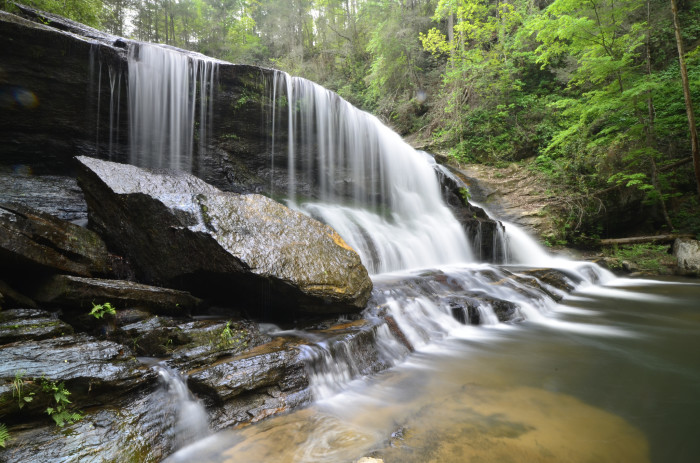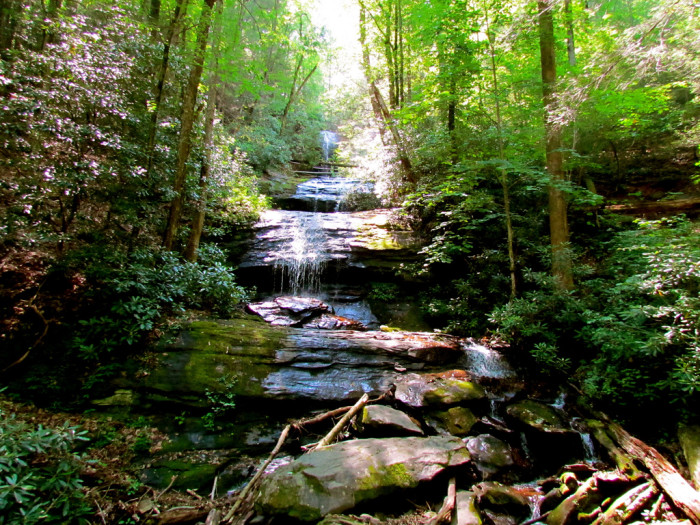The mission of the Atlanta Botanical Garden is to develop and maintain plant collections for display, education, research, conservation and enjoyment.
2010 – present
2010 Grand opening of the Canopy Walk, Edible Garden and Cascades Garden marks completion of expansion project nearly doubling the size of the Garden
2011 Atlanta Blooms debuts first year as the new springtime exhibition featuring hundreds of thousands of bulbs; Garden Lights, Holiday Nights tradition opens with one million energy-efficient LED lights
2012 Woodruff Foundation awards the Garden with $2.5 million gift for development of Atlanta Botanical Garden, Gainesville.
2013 Ron Determann honored by the Garden Club of America for conservation work; Ground broken for Atlanta Botanical Garden, Gainesville; Garden nets record attendance with more than 525,000 visitors
2014 Construction begins on Atlanta Botanical Garden, Gainesville; New restaurant partnership with Chef Linton Hopkins for The Café at Linton’s in the Garden; Garden kicks off $50 million Nourish & Flourish capital campaign for new and renovated gardens and facilities.
2015 Bruce Munro: Light in the Garden is presented as the summer exhibition; The Atlanta Botanical Garden, Gainesville, opens its first phase of development.
2016 The Garden welcomes an encore exhibition of Dale Chihuly’s art, Chihuly in the Garden; A new restaurant, Linton’s, opens, featuring James Beard Award-winning Chef Linton Hopkins’ cuisine; The renovated Children’s Gardens opens and is renamed the Lou Glenn Children’s Garden. The first book about the Garden, Urban Oasis: The Atlanta Botanical Garden, is published.
2000 – 2009
2000 Smithgall family donates 168 acres in Gainesville for Arboretum; Garden introduces double-flowered Sarracenia leucophylla “Tarnok”
2001 U.S. Fish & Wildlife Grant received for restoration of mountain habitat; groundbreaking held for Mershon Hall
2002 Newly designed web site launches; Fuqua Orchid Center/Center for Conservation and Education opens; Mary Pat Matheson named Executive Director; Scarecrow Festival, Orchid Daze exhibits held
2003 Mershon Hall (formerly known as Exhibit Hall) opens; Parterre Garden wins urban landscape award; TREEmendous TREEhouses exhibit staged; Concerts in the Garden held; Cocktails in the Garden begins; Harlequin Toad Atleopus varius discovered not extinct; membership exceeds 12,000
2004 Blockbuster Chihuly in the Garden exhibition staged; 20th Anniversary of Gardens for Connoisseurs Tour held; Smithgall Arboretum greenhouse and nursery open; Plant Sale moves to Smithgall; visitation hits 425,000
2005 Locomotion in the Garden, Trains Across Georgia exhibition opens
2006 Niki in the Garden exhibition is a great success, redesigned web site launches
2007 David Rogers’ Big Bugs & KILLER PLANTS draws summertime crowds with a wealth of programming
2008 Sculpture in Motion, Art Choreographed by Nature is the Garden’s first multi-artist show and features kinetic, moving art
2009 Springtime sees Moore in America, the largest exhibition of monumental, bronze outdoor sculptures of Henry Moore; the new Visitor Center & Garden Gift Shop debut, and the SAGE green parking facility opens along with new gardens
1990 – 1999
1990 Torreya taxifolia safeguarding initiative begins
1991 “Conservation” added to Atlanta Botanical Garden mission statement; Alston Overlook constructed
1992 “Concerts on the Lawn” held; Atlanta Botanical Garden hosts International Waterlily Society conference; Robert Bowden becomes Executive Director
1993 Alston Glenn named Executive Director; GGIA Award received for Robinson Fern Glade
1994 Micropropagation lab opened and named for Ron Determann
1995 Iseli Award recognizes Garden Southern Conifer Garden; Garden becomes founding member of the Georgia Plant Conservation Alliance
1996 Garden Design magazine names Fuqua Conservatory one of top three in U.S.; Red Venus Fly Trap “Akai Ryu” introduced; first Garden collecting trip to China made
1997 Garden hosts International Carnivorous Plant Society Conference
1998 Titan Arum, Amorphophallus titanum, brought into bloom and receives worldwide publicity; Capital Campaign III raises $16 million; Hosta collection established by Greater Atlanta Hosta Society; U.S. Fish & Wildlife Grant awarded for conservation of mountain bogs
1999 Children’s Healthcare of Atlanta Children’s Garden opens; Garden hosts Endangered Plant Committee of World Conservation Union’s Species Survival Commission; Garden brings Cymbidella pardalina into bloom
1980 – 1989
1980 50-year lease executed with City; first Garden of Eden Ball staged
1981 Raiford Intern program founded
1982 Education program expanded
1983 50,000 people visit the Garden
1984 Garden Associates founded by Peggy Martin; First Annual Gardens for Connoisseurs Tour; Storza Woods fenced and reclamation starts; first concerts on the great lawn held
1985 GardenHouse opens; Capital Campaign I raises $3 million
1986 Advisory Panel gives expertise; Mildred Pinnell named Horticulturist; newsletter dubbed Clippings published; Troutman Camellia collection planted
1987 Ron Determann named Fuqua Conservatory Superintendent
1988 Garden Mission Statement written; National Advisory Committee evaluates Garden progress; re-start of Southeastern (Atlanta) Flower Show chaired by Pat Hartrampf
1989 Dorothy Chapman Fuqua Conservatory opens; Capital Campaign II raises $6.4 million
1973 – 1979
1973 Civic-minded Atlantans propose a botanical garden for the city
1976 Incorporation of Atlanta Botanical Garden, Inc.
1977 Double-wide trailer assigned to Garden as first office; Bill Warner from Holden Arboretum becomes first full-time Executive Director
1979 Ann Lyon Crammond named second Executive Director; first Plant Sale held; first Country Christmas held


Recent Comments